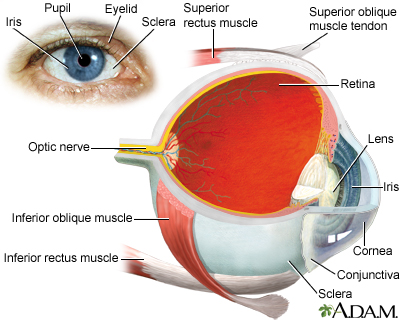Visual field
Perimetry; Tangent screen exam; Automated perimetry exam; Goldmann visual field exam; Humphrey visual field exam
The visual field refers to the total area in which objects can be seen in the side (peripheral) vision as you focus your eyes on a central point.
This article describes the test that measures your visual field.
Images


How the Test is Performed
Confrontation visual field exam. This is a quick and basic check of the visual field. The health care provider sits directly in front of you. You will cover one eye, and stare straight ahead with the other. You will be asked to tell when you can see the examiner's hand.
Tangent screen or Goldmann field exam. You will sit about 3 feet (90 centimeters) away from a flat, black fabric screen with a target in the center. You will be asked to stare at the center target and let the examiner know when you can see an object that moves into your side vision. The object is usually a pin or bead on the end of a black stick that is moved by the examiner. This exam creates a map of your central 30 degrees of vision. This exam is usually used to detect brain or nerve (neurologic) problems.
Goldmann perimetry and Automated perimetry. For either test, you sit in front of a concave dome and stare at a target in the middle. You press a button when you see small flashes of light in your peripheral vision. With Goldmann testing, the flashes are controlled and mapped out by the examiner. With automated testing, a computer controls the flashes and mapping. Your responses help determine if you have a defect in your visual field. Both tests are often used to track conditions that may worsen over time.
Your provider will discuss with you the type of visual field testing to be done.
How to Prepare for the Test
No special preparation is necessary.
How the Test will Feel
There is no discomfort with visual field testing.
Why the Test is Performed
This eye exam will show whether you have a loss of vision anywhere in your visual field. The pattern of vision loss will help your provider diagnose the cause.
Normal Results
The peripheral vision is normal.
What Abnormal Results Mean
Abnormal results may be due to diseases or central nervous system (CNS) disorders, such as tumors that damage or press on (compress) the parts of the brain that deal with vision.
Other diseases that may affect the visual field of the eye include:
- Diabetes
- Glaucoma (increased eye pressure)
- High blood pressure
- Age-related macular degeneration (eye disorder that slowly destroys sharp, central vision)
- Multiple sclerosis (disorder that affects the CNS)
- Optic nerve glioma (tumor of the optic nerve)
- Hyperthyroidism (overactive thyroid)
- Pituitary gland disorders
- Retinal detachment (separation of the retina in the back of the eye from its supporting layers)
- Stroke
- Temporal arteritis (inflammation and damage to the arteries that supply blood to the scalp and other parts of the head)
Risks
The test has no risks.
Related Information
Central nervous systemDiabetes
Hyperthyroidism
High blood pressure in adults - hypertension
Multiple sclerosis
Glaucoma
Optic glioma
Stroke
References
Chuck RS, Dunn SP, Flaxel CJ; American Academy of Ophthalmology Preferred Practice Pattern Committee, et al. Comprehensive adult medical eye evaluation preferred practice pattern. Ophthalmology. 2021;128(1):1-29. doi.org/10.1016/j.ophtha.2020.10.024. Published November 12, 2020.
Idrees S, Sangave AA, Ramchandran RS. Visual fields in retinal disease. In: Sadda SR, Sarraf D, Freund KB, Hinton DR, Schachat AP, Wilkinson CP, eds. Ryan's Retina. 7th ed. Philadelphia, PA: Elsevier; 2023:chap 13.
Olitsky SE, Marsh JD. Examination of the eye. In: Kliegman RM, St. Geme JW, Blum NJ, Shah SS, Tasker RC, Wilson KM, eds. Nelson Textbook of Pediatrics. 21st ed. Philadelphia, PA: Elsevier; 2020:chap 637.
Schroeder R, Lind JT, Budenz DL. Visual fields. In: Yanoff M, Duker JS, eds. Ophthalmology. 6th ed. Philadelphia, PA: Elsevier; 2023:chap 10.5.
BACK TO TOPReview Date: 2/12/2023
Reviewed By: Franklin W. Lusby, MD, Ophthalmologist, Lusby Vision Institute, La Jolla, CA. Also reviewed by David C. Dugdale, MD, Medical Director, Brenda Conaway, Editorial Director, and the A.D.A.M. Editorial team.

Health Content Provider
06/01/2025
|
A.D.A.M., Inc. is accredited by URAC, for Health Content Provider (www.urac.org). URAC's accreditation program is an independent audit to verify that A.D.A.M. follows rigorous standards of quality and accountability. A.D.A.M. is among the first to achieve this important distinction for online health information and services. Learn more about A.D.A.M.'s editorial policy, editorial process and privacy policy. A.D.A.M. is also a founding member of Hi-Ethics. This site complied with the HONcode standard for trustworthy health information from 1995 to 2022, after which HON (Health On the Net, a not-for-profit organization that promoted transparent and reliable health information online) was discontinued. |
The information provided herein should not be used during any medical emergency or for the diagnosis or treatment of any medical condition. A licensed medical professional should be consulted for diagnosis and treatment of any and all medical conditions. Links to other sites are provided for information only -- they do not constitute endorsements of those other sites. © 1997- 2025 A.D.A.M., a business unit of Ebix, Inc. Any duplication or distribution of the information contained herein is strictly prohibited.
